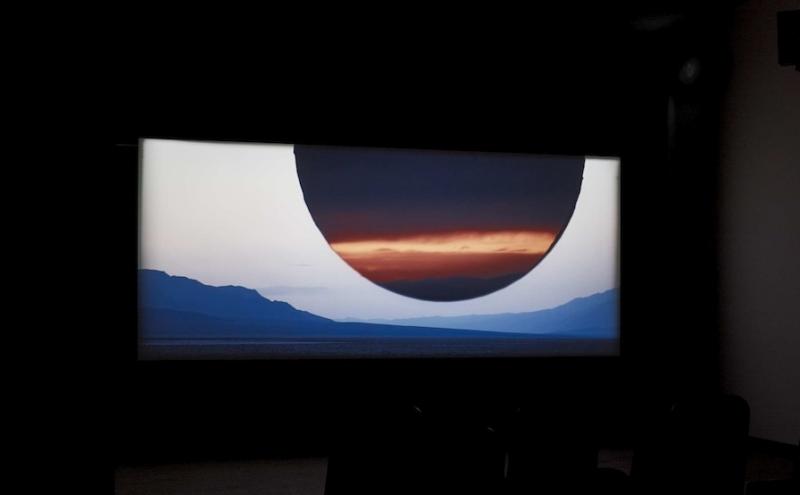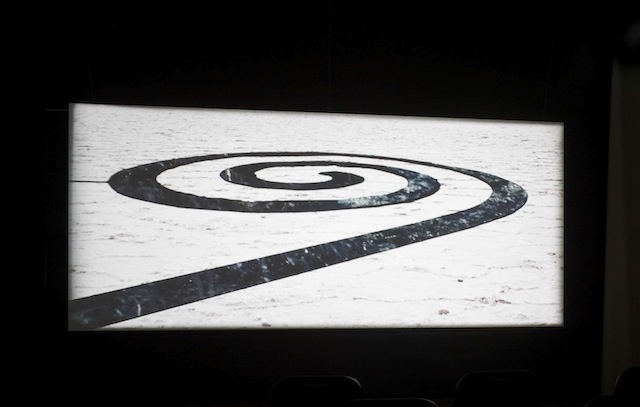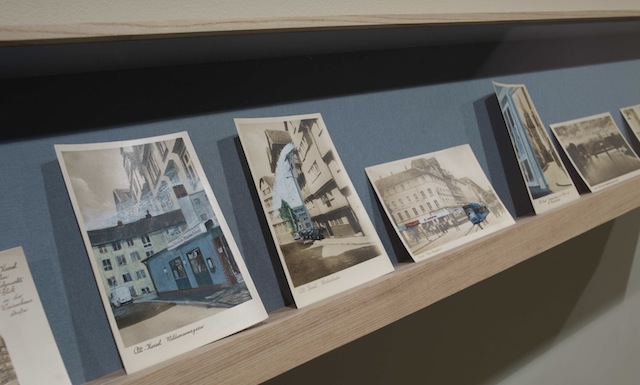Tacita Dean, Frith Street Gallery | reviews, news & interviews
Tacita Dean, Frith Street Gallery
Tacita Dean, Frith Street Gallery
A subtle and powerful new film inspired by JG Ballard and Robert Smithson's iconic earthwork Spiral Jetty

In 1970 the American artist Robert Smithson took several tonnes of mud and rock and built a jetty out into the Great Salt Lake in Utah. Instead of making a single, straight line, Smithson’s jetty curved round on itself and formed a spiral. Since no boat can dock at a spiral jetty, it joined Méret Oppenheim’s fur-lined teacup and Man Ray’s nail-studded clothes iron as an object whose function was subverted.
One man could see a use for it, though. JG Ballard, with characteristic inventiveness, saw it as an invitation and landing place for a giant clock, bringing the gift of time to the desert “where time hasn’t existed for hundreds of millions of years”. Ballard was a big fan of Smithson, and the American returned the compliment. When Smithson died just three years later, collections of Ballard’s short stories were found among his belongings. One of those stories, The Voices of Time, concerns the carving of huge ideograms into the landscape and so bears an uncanny thematic similarity to Smithson’s work.
Dean has assembled one hundred postcards of Kassel from the decades before the war
Now Tacita Dean joins the two men to complete a triad of artists and writers working away at the same idea. Her film at the Frith Street Gallery, JG (Dean was a friend of Ballard’s and corresponded with him), is a montage of outdoor scenes, mostly filmed in Utah. At times the screen splits into two or three parts, each showing a discrete vista. It appears to be a world wholly made up of water and stone. Vast stretches of it might be composed entirely of salt crystals. It is not always possible to get a sense of scale. Some kind of mining operation seems to be going on with diggers, trucks and freight trains, though no people are discernible. The machinery is carrying on a life as purposeful and mysterious as the lizards and armadillos that are the only living things in sight.
Every now and then, the shape of Smithson’s spiral is superimposed over the wax-coloured landscape (pictured below). A voiceover (provided by the actor Jim Broadbent) intermittently reads out snatches from the Ballard story. There is a sense of being in the aftermath of a catastrophe, but also a contradictory sense of placidity and lack of urgency. The whole thing is, in short, Ballardian.
 On the night of 22nd October 1943 British aircraft set off to bomb the ancient German city of Kassel. In April 1945, just weeks before the end of the Second World War, American troops attacked the town and fought a stupendous battle with the Wehrmacht amongst the ruins. When it was all over, nearly every fragment of the medieval and baroque city had been destroyed. Rebuilding in the 1950s favoured modern architecture, and the old town was not restored. All that remains of it now is the photographic record and the memories of those old enough to have seen it before the Forties. Soon only the former will remain.
On the night of 22nd October 1943 British aircraft set off to bomb the ancient German city of Kassel. In April 1945, just weeks before the end of the Second World War, American troops attacked the town and fought a stupendous battle with the Wehrmacht amongst the ruins. When it was all over, nearly every fragment of the medieval and baroque city had been destroyed. Rebuilding in the 1950s favoured modern architecture, and the old town was not restored. All that remains of it now is the photographic record and the memories of those old enough to have seen it before the Forties. Soon only the former will remain.
Dean has assembled one hundred postcards of Kassel from the decades before the war and presented them in long cabinets along the otherwise bare basement walls of the gallery (pictured below). Inspecting them is like looking down into a tiny, infinitely delicate world. Dean went to Kassel and visited the locations shown in the postcards. She then painted what she saw on to the old tobacco-coloured pictures. Her interventions are sometimes subtle and small-scale: cars, modern street signs, a glass building among the old stonework. Sometimes they take the form of a tree or green lawn expanding across the photo’s surface. Once or twice the paint grows to obliterate the photograph underneath. The postcards now show the beautiful and complacent city before the catastrophe, mixed with scraps of the peaceful and contemporary town, with no hint of the trauma in between. It is a picture of a life the city might have lived had it not been for the war.
 The two halves of the exhibition do not make a connected whole, although both are concerned with the passage of time, erosion and change. The first – the film showing in main ground-floor room – is semi-abstract, suggestive and allusive. The second goes for its subject in a much more direct way, though it has been shoved away down in that empty, slightly sinister underground room. As calm and as quiet as both these works appear, they deliver their respective messages with force.
The two halves of the exhibition do not make a connected whole, although both are concerned with the passage of time, erosion and change. The first – the film showing in main ground-floor room – is semi-abstract, suggestive and allusive. The second goes for its subject in a much more direct way, though it has been shoved away down in that empty, slightly sinister underground room. As calm and as quiet as both these works appear, they deliver their respective messages with force.
Explore topics
Share this article
more Visual arts
 Fantastic Machine review - photography's story from one camera to 45 billion
Love it or hate it, the photographic image has ensnared us all
Fantastic Machine review - photography's story from one camera to 45 billion
Love it or hate it, the photographic image has ensnared us all
 Yinka Shonibare: Suspended States, Serpentine Gallery review - pure delight
Weighty subject matter treated with the lightest of touch
Yinka Shonibare: Suspended States, Serpentine Gallery review - pure delight
Weighty subject matter treated with the lightest of touch
 Jane Harris: Ellipse, Frac Nouvelle-Aquitaine MÉCA, Bordeaux review - ovals to the fore
Persistence and conviction in the works of the late English painter
Jane Harris: Ellipse, Frac Nouvelle-Aquitaine MÉCA, Bordeaux review - ovals to the fore
Persistence and conviction in the works of the late English painter
 Sargent and Fashion, Tate Britain review - portraiture as a performance
London’s elite posing dressed up to the nines
Sargent and Fashion, Tate Britain review - portraiture as a performance
London’s elite posing dressed up to the nines
 Zineb Sedira: Dreams Have No Titles, Whitechapel Gallery review - a disorientating mix of fact and fiction
An exhibition that begs the question 'What and where is home?'
Zineb Sedira: Dreams Have No Titles, Whitechapel Gallery review - a disorientating mix of fact and fiction
An exhibition that begs the question 'What and where is home?'
 Yoko Ono: Music of the Mind, Tate Modern review - a fitting celebration of the early years
Acknowledgement as a major avant garde artist comes at 90
Yoko Ono: Music of the Mind, Tate Modern review - a fitting celebration of the early years
Acknowledgement as a major avant garde artist comes at 90
 Unravel: The Power and Politics of Textiles in Art, Barbican review - the fabric of dissent
An ambitious exploration of a neglected medium
Unravel: The Power and Politics of Textiles in Art, Barbican review - the fabric of dissent
An ambitious exploration of a neglected medium
 When Forms Come Alive, Hayward Gallery review - how to reduce good art to family fun
Seriously good sculptures presented as little more than playthings or jokes
When Forms Come Alive, Hayward Gallery review - how to reduce good art to family fun
Seriously good sculptures presented as little more than playthings or jokes
 Entangled Pasts 1768-now, Royal Academy review - an institution exploring its racist past
After a long, slow journey from invisibility to agency, black people finally get a look in
Entangled Pasts 1768-now, Royal Academy review - an institution exploring its racist past
After a long, slow journey from invisibility to agency, black people finally get a look in
 Barbara Kruger, Serpentine Gallery review - clever, funny and chilling installations
Exploring the lies, deceptions and hyperbole used to cajole, bully and manipulate us
Barbara Kruger, Serpentine Gallery review - clever, funny and chilling installations
Exploring the lies, deceptions and hyperbole used to cajole, bully and manipulate us
 Richard Dorment: Warhol After Warhol review - beyond criticism
A venerable art critic reflects on the darkest hearts of our aesthetic market
Richard Dorment: Warhol After Warhol review - beyond criticism
A venerable art critic reflects on the darkest hearts of our aesthetic market
 Dineo Seshee Raisibe Bopape: (ka) pheko ye / the dream to come, Kiasma, Helsinki review - psychic archaeology
The South African artist evokes the Finnish landscape in a multisensory installation
Dineo Seshee Raisibe Bopape: (ka) pheko ye / the dream to come, Kiasma, Helsinki review - psychic archaeology
The South African artist evokes the Finnish landscape in a multisensory installation

Add comment